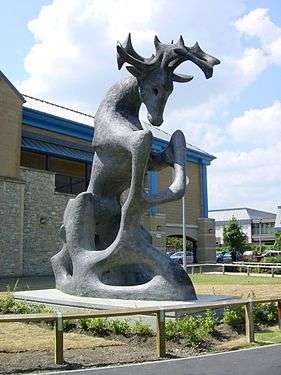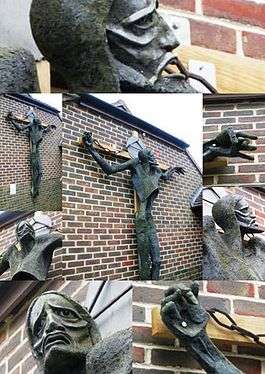Edward Bainbridge Copnall
| Edward Bainbridge Copnall | |
|---|---|
| Born |
29 August 1903 Cape Town, South Africa |
| Died |
18 October 1973 (aged 70) Littleborne, Kent, England |
| Nationality | British |
| Education | Goldsmiths College, Royal Academy |
| Known for | Sculpture |
| Awards | MBE |
Edward Bainbridge Copnall MBE (29 August 1903 – 18 October 1973) was a British sculptor and painter. Best known for his architectural and decorative sculptures featuring allegorical and religious subjects.[1] He was the President of the Royal Society of Sculptors from 1961 - 1966.
Early life and career

Edward Bainbridge Copnall was born in Cape Town, South Africa in 1903 and moved to Horsham, West Sussex in England as a young child after the death of his mother. His father, photographer Edward White Copnall (born 1878, Isle of Wight), lived and worked in Horsham from 1915-1962.[2] His uncle was Liverpool-based portrait painter Frank Thomas Copnall (1870-1948).[3] The Copnall family have a long association with Horsham, the street Copnall Way is named after them.[4]
The exterior sculptural scheme for the Royal Institute of British Architects new building in Portland Place, London, completed in 1934, was an important early commission.[4]
In the Second World War, he worked as a camouflage officer in the Middle East, building dummies as part of the military deception for Operation Crusader.[5] Copnall lived in Burma from 1955 to 1956, and completed 50-60 paintings,[6] mainly portraits, during that time. He was also commissioned to do a memorial of General Aung San, the first Prime Minister of Free Burma. The statue was unveiled in Burma in 1955.[4]
He was president of the Royal Society of British Sculptors from 1961 to 1966. Bainbridge Copnall wrote A Sculptor's Manual, published in 1971, and Cycles: An Autobiography - The Life and Work of a Sculptor, published in 2001. His son is artist John Copnall (1928-2007).
Notable works
- Whither, 1925. An allegorical painting depicting a funeral in a Horsham graveyard, Horsham Museum & Art Gallery.[7]
- Architectural Aspiration, 1934, exterior and interior, Royal Institute of British Architects
- Sight and Sound panels, 1938, Warner Theatre, Leicester Square, London
- Wood carvings for the Cunard Line liners RMS Queen Mary and RMS Queen Elizabeth[8][9]
- St James's Theatre panels, 1959, four horizontal bas-relief panels at the site of St James's Theatre, London. Depicts the heads of Gilbert Miller, George Alexander, Oscar Wilde, and Laurence Olivier and Vivien Leigh)[10]
- The Stag, 1962, Maidstone, Kent. His largest work, originally located in Stag Place, London but moved to Maidstone in 2004.
- Crucifixion of Jesus, 1964, St John's Church, Horsham. Made from coal dust and resin, it was removed from the facade of the church in December 2008 to Horsham Museum and Art Gallery. Rev Ewen Souter, the vicar at St John's Church called said it was "a horrifying depiction of pain and suffering" that 'scared children and deterred worshippers'.[11][12]
- Thomas Becket, 1970, St. Paul's Cathedral Churchyard, London
- The Boy David, 1971, Chelsea Embankment
- exterior work at St. Columba's Church, Pont Street, London [8]
Gallery
 The Stag, Maidstone
The Stag, Maidstone The Boy David, Chelsea Embankment, London
The Boy David, Chelsea Embankment, London Thomas Becket, St Paul's Churchyard, London
Thomas Becket, St Paul's Churchyard, London Crucifixion of Jesus, St John's Church, Horsham
Crucifixion of Jesus, St John's Church, Horsham
External links
| Wikimedia Commons has media related to Edward Bainbridge Copnall. |
- Copnall, Edward Bainbridge (1903-1973) Sculptor A comprehensive biography on The National Archives website-includes many photographs of Bainbridge Copnall's work.
References
- ↑ Chilvers, Ian; Glaves-Smith, John, eds. (2009). "Copnall, Edward Bainbridge". A Dictionary of Modern and Contemporary Art. Oxford University Press. p. 156. ISBN 9780199239658.
- ↑ Slyfield, Brian (September 2002). "EW Copnall - photographer of nawabs, rajahs, even British royalty" (PDF). The Horsham Society Newsletter: 56. Retrieved 30 May 2016.
- ↑ "Portrait of His Imperial Majesty, Haile Selassie I, Emperor of Ethiopia (1892 -1975 ) wearing the order of the Garter". Artware fine art. Retrieved 30 May 2016.
- 1 2 3 "Copnall, Edward Bainbridge (1903-1973) Sculptor". Your Archives. The National Archives. Retrieved 30 May 2016.
- ↑ Barkas, Geoffrey (1952). The Camouflage Story: from Aintree to Alamein. Cassell. p. 141.
- ↑ Ranard, Andrew (2009). Burmese Painting: A Linear and Lateral History. Silkworm Books. ISBN 9789749511763. Retrieved 30 May 2016.
- ↑ "'Whither'". Art UK. Retrieved 11 August 2016.
- 1 2 Windsor, Alan, ed. (2003). "Edward Bainbrigde Copnall MBE PRBS". British Sculptors of the Twentieth Century. Ashgate. ISBN 9781859284568.
- ↑ Wuellner, Margarita J.; et al, (2009). "Final Inventory Report: Survey of Original of Fine and Decorative Arts on the Royal Mail Ship Queen Mary" (PDF).
- ↑ "St. James's Theatre, King Street, London, SW1". arthurlloyd.co.uk. Retrieved 11 August 2016.
- ↑ "Church removes 'scary crucifix'". BBC News. 7 January 2009. Retrieved 29 May 2016.
- ↑ Pidd, Helen (6 January 2009). "Vicar has 'horrifying' statue of crucifixion removed from church". Guardian. Retrieved 29 May 2016.